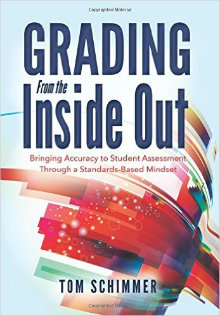Solving the Puzzle of Standards Based Grading
Grading From the Inside Out: Bringing Accuracy to Student Assessment Through a Standards-Based Mindset
By Tom Schimmer
(Solution Tree, 2016 – Learn more)
Reviewed by Jennifer Wirtz

Needless to say, two years later, I am still “learning as I go” and am still struggling with the process and the long-term effects that the switch will have on the students. I have exhaustively looked for resources to make it easier on me, and quite frankly, on all who are involved in the new system.
The high school that we feed into has reported back that they have never seen a group of students so unprepared for the academic rigor of high school, that there is a distinct rise in social work-related issues tied to anxiety within the current freshmen class. They want to know what we (and they) can do to help better prepare these students for the demands of high school and, more importantly, beyond.
At the middle school, we worry daily that there is a connection between how we are preparing these students for the real world, and our lack of understanding about how to implement a SBG paradigm effectively. The struggle is real.
A missing sense of urgency

I was hoping that this text would provide me with the “answers,” or at least the guidance to keep progressing in a positive way. I guess I just never approached the ABCDF mindset as “punitive,” but rather as a reflection of what the student had earned through their work completion, which is how I see SBG as well.
We have a very real problem in our building with students lacking basic executive functioning skills. There is no motivation to complete work well the first time, when the students know they can redo the assignment (as many times as needed) to get a better mark. Student confidence has been misdirected towards the mindset that there is no real urgency to complete the assignment.
I thought this text’s topic could enlighten me on how to better manage and approach my lessons and expectations for my students, to create that sense of urgency. While I am still not entirely embracing the SBG pedagogy, I have found solace in understanding more than I did before. Most important for me is that I agree with the author when he states that we need to create alignment and consistency so that teachers are in sync as to how they assess and report student proficiency (p.30).
The hunt continues . . .
Tom Schimmer lays out the need to institutionalize new approaches and to transform archaic grading practices. A “standards-based mindset” is crucial for the implementation of these new grading practices to become best-practice. One thing he stresses throughout the text is that change takes time, it is messy, and it is hard. I agree.
The author attempts to provide feasible practices to navigate the change to a standards-based instructional paradigm. He uses the metaphor of a compass, with SBG mindset being true North, often in the text. The metaphor helps the reader to stay focused on trying to understand what it takes to get there, or at the very least, to keep trucking forward in our attempts to get to our destination.
I agree that meaningful grades are imperative for students on their academic journeys, but if there are no clear boundaries on how to collectively grade on “achievement” only, the clear and consistent message is lost. It is discussed in the text that students become more confident about taking risks and trying something new when they know they have a safety net. I am hoping this is true.
I didn’t find all my answers here. Until I do, I will continue on my journey to find a variation of implementation that works for me because I do believe in the merits of idea of an SBG mindset, even though I still struggle to see success within the paradigm shift as of yet.
Jennifer Wirtz has been a 7th and 8th grade English Language Arts teacher at Gemini Junior High School in Niles, Illinois for over a decade. She received a B.A. and a B.S. from Loyola University Chicago and a Masters in Education from DePaul University. Currently she is also finishing up a three year stint as a Design Teacher in the Project READI research program at the University of Illinois-Chicago. She is married to a math teacher and has two young children.



































